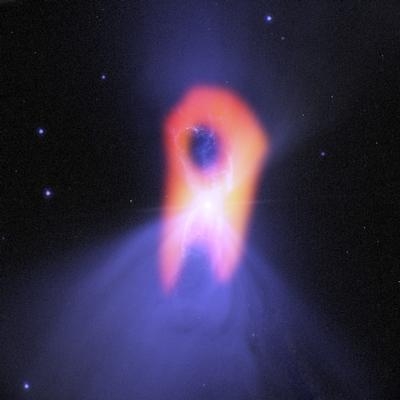Mon, Nov 04, 2013
Boomerang Nebula Structure 'Expanding Rapidly Into Space'
At a cosmologically crisp one degree Kelvin (minus 458 degrees Fahrenheit), the Boomerang nebula is the coldest known object in the universe -- colder, in fact, than the faint afterglow of the Big Bang, the explosive event that created the cosmos. Astronomers using the Atacama Large Millimeter/submillimeter Array (ALMA) telescope in Chile have taken a new look at this object to learn more about its frigid properties and to determine its true shape, which has an eerily ghost-like appearance.

"This ultra-cold object is extremely intriguing and we're learning much more about its true nature with ALMA," said Raghvendra Sahai, a researcher and principal scientist at NASA's Jet Propulsion Laboratory in Pasadena, CA, and lead author of a paper published in the Astrophysical Journal. “What seemed like a double lobe, or boomerang shape, from Earth-based optical telescopes, is actually a much broader structure that is expanding rapidly into space."
As originally observed with ground-based telescopes, this nebula appeared lopsided, which is how it got its name. Later observations with NASA's Hubble Space Telescope revealed a bow-tie-like structure. The new ALMA data, however, reveal that the Hubble image tells only part of the story, and the twin lobes seen in that image may actually be a trick of light as seen at visible wavelengths.
The researchers discovered a dense lane of millimeter-sized dust grains surrounding the star, which explains why its outer cloud has an hourglass shape in visible light. These minute dust grains have created a mask that shades a portion of the central star and allows its light to leak out only in narrow but opposite directions into the cloud, giving it an hourglass appearance. "This is important for the understanding of how stars die and become planetary nebulas,” said Sahai. “Using ALMA, we were quite literally, and figuratively, able to shed new light on the death throes of a sun-like star."
The Boomerang nebula, located about 5,000 light-years away in the constellation Centaurus, is a relatively young example of an object known as a planetary nebula. Planetary nebulas, contrary to their name, are actually the end-of-life phases of stars like our sun that have sloughed off their outer layers. What remains at their centers are white dwarf stars, which emit intense ultraviolet radiation that causes the gas in the nebulae to glow and emit light in brilliant colors.
(Image provided by NASA)
More News
Aero Linx: Model Aeronautical Association of Australia MAAA clubs are about fun flying, camaraderie and community. For over 75 years, the MAAA has been Australia’s largest fl>[...]
Touchdown Zone Lighting Two rows of transverse light bars located symmetrically about the runway centerline normally at 100 foot intervals. The basic system extends 3,000 feet alon>[...]
“Discovery and innovation are central to our mission at Virgin Galactic. We’re excited to build on our successful record of facilitating scientific experiments in subor>[...]
How To Get A Story On Aero-TV News/Feature Programming How do I submit a story idea or lead to Aero-TV? If you would like to submit a story idea or lead, please contact Jim Campbel>[...]
Student Pilot Reported That During Rotation, “All Of A Sudden The Back Of The Plane Kicked To The Right..." Analysis: The student pilot reported that during rotation, “>[...]
 ANN's Daily Aero-Linx (05.02.24)
ANN's Daily Aero-Linx (05.02.24) ANN's Daily Aero-Term (05.02.24): Touchdown Zone Lighting
ANN's Daily Aero-Term (05.02.24): Touchdown Zone Lighting Aero-News: Quote of the Day (05.02.24)
Aero-News: Quote of the Day (05.02.24) ANN FAQ: Contributing To Aero-TV
ANN FAQ: Contributing To Aero-TV NTSB Final Report: Cirrus Design Corp SR20
NTSB Final Report: Cirrus Design Corp SR20



